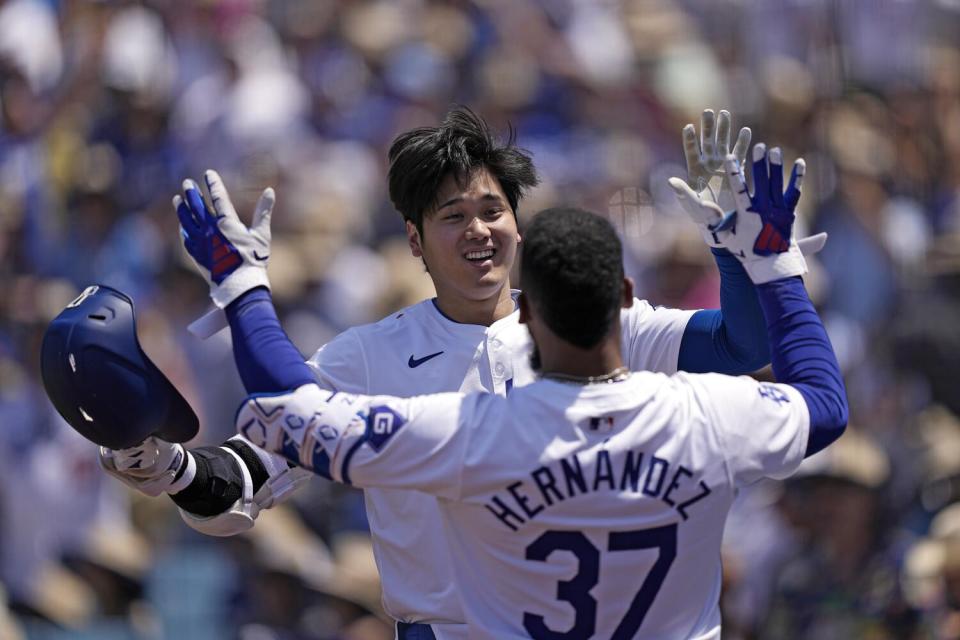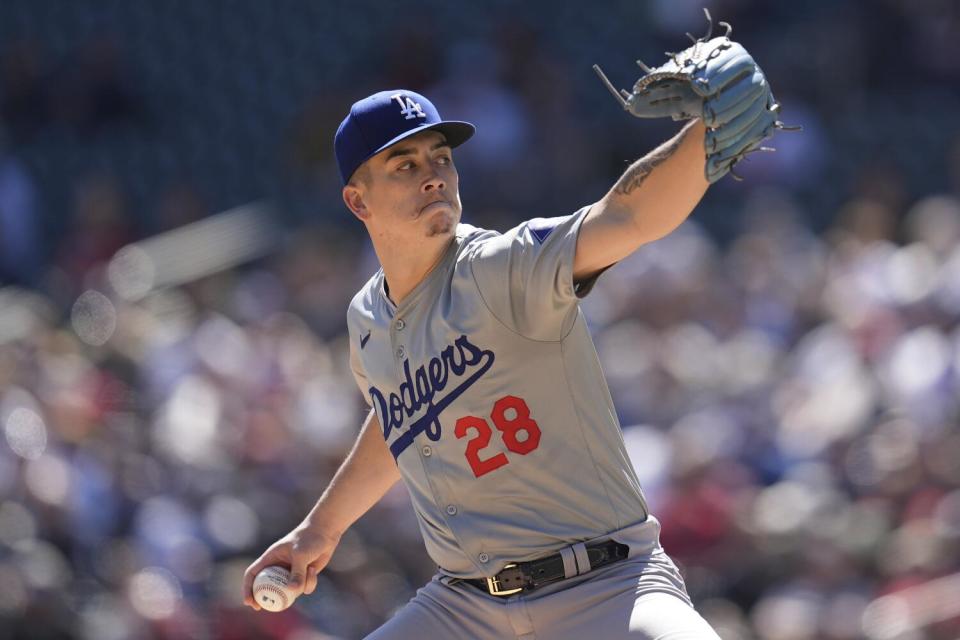Four ways the Mookie Betts and Yoshinobu Yamamoto injuries impact the Dodgers
Amid the doom of dire injury updates, and gloom of two star players being sidelined the foreseeable future, Dodgers manager Dave Roberts dropped in a dash of optimism Sunday afternoon.
“We’ll be fine,” Roberts insisted, even as he announced Mookie Betts had a fractured hand and Yoshinobu Yamamoto had a strained rotator cuff. “We have really good players.”
That much is true. Even with Betts and Yamamoto sidelined for the foreseeable future, the Dodgers have a likely MVP candidate (Shohei Ohtani), a possible Cy Young contender (Tyler Glasnow) and a handful of other potential All-Stars.
They have an eight-game division lead in the National League West, and the depth to preserve it over the second half of the season.
Read more: Hernández: Mookie Betts and Yoshinobu Yamamoto injuries create a Dodgers trade deadline dilemma
Long-term, the Dodgers are still counting on Betts and Yamamoto to be back by the playoffs, hopeful neither player’s injury will require surgery or be season-ending.
But whether the club can be as good as it was before this woebegone weekend, whether their championship hopes took any dash when Yamamoto felt tightness in his throwing arm or Betts got plunked with a pitch in his left hand — that, only time will tell.
As they return to the field Monday, sans two of their brightest star players, here are four ways the club could be affected.

Lineup shuffle
The simplest short-term change for the Dodgers to make is in their batting order.
With Betts, their leadoff hitter, sidelined, the Dodgers can slide their other star bats up a spot in the lineup, with Ohtani serving as the temporary leadoff hitter, followed by Freddie Freeman, Will Smtih and Teoscar Hernández.
The top of the order will still be a threat.
Defensively, though, the ramifications could be more complex.
Roberts said sure-handed veteran infielder Miguel Rojas will primarily take over at shortstop for now. However, the 35-year-old has already dealt with leg soreness in a part-time capacity (Rojas has started only 30 of 73 games, even with a .278 batting average) and probably will need to be spelled regularly by others, such as utilityman Kiké Hernández.
That should give the Dodgers enough cover at shortstop, where Betts’ defense had graded poorly, by major league standards, in his first year playing the position full-time since high school.
But it will also eat into the Dodgers’ versatility in the field — forcing a team that once had myriad ways to deploy its roster (for example, platooning Rojas at second base with Gavin Lux) to work harder to make the pieces fit.

Rotation recalibration
Since the week the Dodgers acquired Glasnow and Yamamoto this offseason, it was clear those two would be the anchors in their rotation.
Glasnow and Yamamoto were not only the highest-paid pitchers on the team, costing the Dodgers more than half a billion to add this offseason, but they were also the most established — Glasnow (who is 7-5 with a 3.00 ERA) as a supremely talented, albeit injury-plagued, MLB veteran; Yamamoto (6-2, 2.92 ERA) as one of the most decorated pitchers in Japan’s Nippon Professional Baseball league.
From the start, they were tagged as co-aces. Now, with Yamomoto’s timeline to return (or ability to perform once he does) unclear, half that responsibility will have to be shouldered somewhere else.
Internally, the best candidates might be the Dodgers’ youngest ones.
Gavin Stone is having a breakout season, currently 10th in the NL with a 3.01 ERA. Bobby Miller had similar success last season, with a 3.76 ERA, and is set to return from a shoulder injury Wednesday.
Both have the stuff to keep taking steps forward. And now, their importance to the team stands to grow.
The Dodgers also have more well-known veterans, including James Paxton (6-1, 3.92 ERA), Walker Buehler (1-4, 4.64 ERA) and Clayton Kershaw (who will soon begin a rehabilitation assignment after shoulder surgery this offseason).
That group, however, is more fraught with questions. Paxton’s command has been frustratingly inconsistent, with 32 walks in less than 60 innings. Buehler has struggled in his return from a second Tommy John surgery, giving up fewer than three runs only once. Kershaw is coming back from his first career surgery at age 36.
With time, maybe one of them will round into form. Perhaps someone else (such as Dustin May, who is also working his way back from surgery) will emerge as a surprise weapon.
In the meantime, though, the Dodgers’ list of legitimate No. 2 starters in Yamamoto’s absence is somewhat thin, beginning (and maybe also ending) with the two youngest members of their rotation.
Deadline pitching help
The other option, of course, is for the Dodgers to canvas the trade market before the July 30 deadline, and seek an external target to bolster their pitching staff.
Read more: Mookie Betts to miss several weeks after sustaining hand fracture in Dodgers' win
The team’s willingness to do so could depend on the severity of Yamamoto’s injury — and the front office’s confidence the 25-year-old will make a full recovery over the next couple of months (it will be at least a few weeks before Yamamoto even starts throwing again, Roberts said).
If the Dodgers do need to make a pitching splash, however, there are few obvious players for them to target.
Some of the most talented potential trade targets this deadline — such as Garrett Crochet of the Chicago White Sox (the AL strikeout leader) or Jesús Luzardo of the Miami Marlins (who had a combined 3.48 ERA in 2022 and 2023) — have multiple years of club control left and will demand lofty returns to acquire.
Among lower-cost arms likely to move this deadline — a group including Tyler Anderson of the Angels, Luis Severino of the New York Mets and Jack Flaherty of the Detroit Tigers, among others — few are certain to be legitimate upgrades over Stone, Miller, Buehler and company.
This was a risk the Dodgers took when they bypassed any other major pitching acquisitions this offseason. Corbin Burnes and Dylan Cease long seemed like fits for L.A. but were ultimately dealt elsewhere earlier this year. The team showed free-agent interest in Aaron Nola early in the winter, and Blake Snell late in the spring, according to people with knowledge of those discussions unauthorized to speak publicly, but landed neither.
Now, acquiring another impact arm could pose a tall task — no matter how much the Dodgers might suddenly need to look.
Long-term infield alignment
Betts’ injury also raises questions about the Dodgers’ long-term infield plans — even when he eventually returns to health.
While the Dodgers had remained bullish on Betts’ defensive capabilities, banking on him to make continued improvement as a shortstop in the coming months, he was no lock to be their everyday starter at the position come the stretch run of the season.
Now, that prospect appears even slimmer.
Betts is about to miss out on weeks, if not months, of valuable shortstop repetitions — both in games and during pregame infield drills.
Without that, it’s unclear if the club will continue its experiment with him at shortstop, or move him back to either second base (where he was originally planning to play this season) or right field (where he is a six-time Gold Glover, but has not played at all this season) upon his return.
Read more: Dodgers hope Yoshinobu Yamamoto's rotator-cuff strain isn't a precursor to major injury
If Betts does move elsewhere, upgrading the shortstop position poses another challenge.
A combination of Rojas and Hernández might be an adequate short-term solution, but is not the most appealing duo for an extended postseason run.
Just like the pitching market, few top shortstops figure to be traded before the deadline, either — including Willy Adames of the Milwaukee Brewers, another player the Dodgers previously targeted.
It’s just one more repercussion from the Dodgers’ injury-ravaged weekend — a turning-point moment that could define their path to championship contention and alter the blueprint of their World Series ambitions.
Sign up for more Dodgers news with Dodgers Dugout. Delivered at the start of each series.
This story originally appeared in Los Angeles Times.

 Yahoo Sport
Yahoo Sport 





































